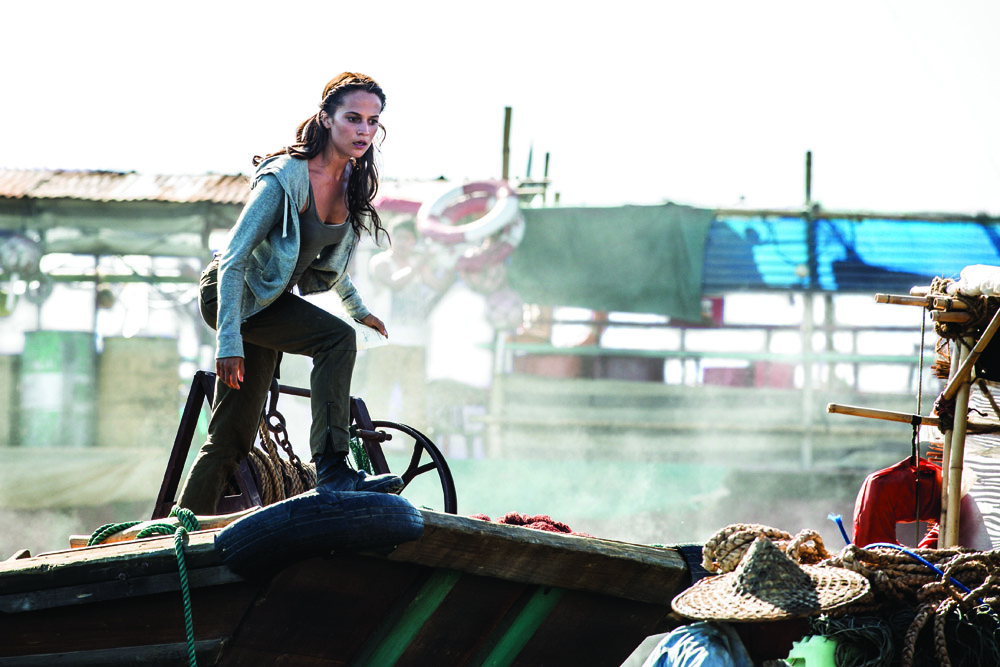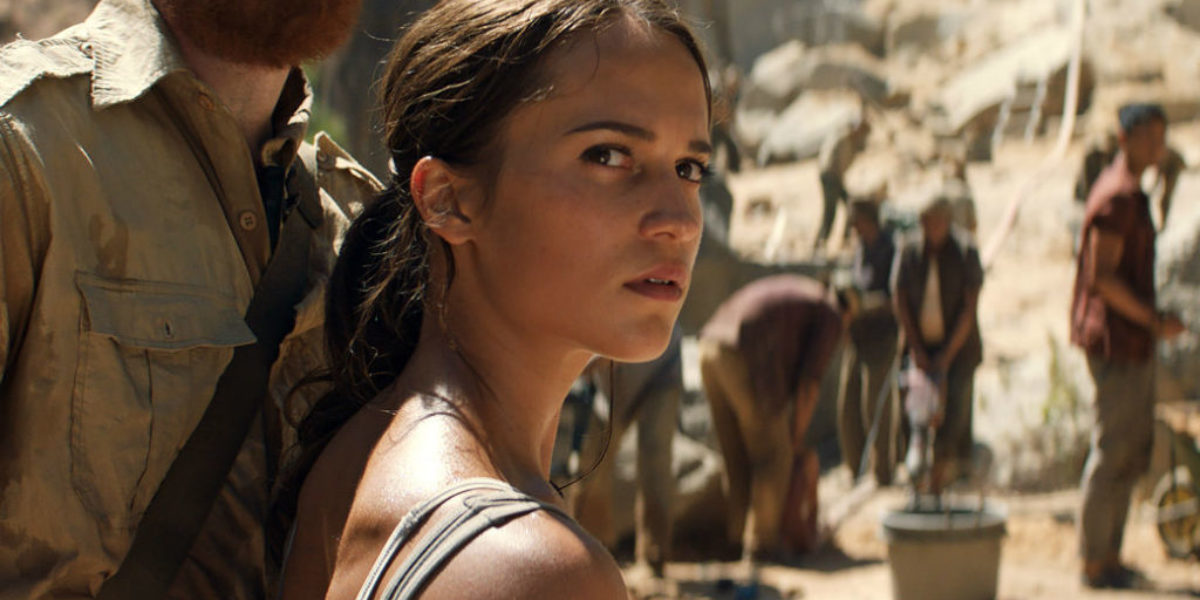Action Woman – Alicia Vikander
No longer a film with a sex-symbol protagonist, the Tomb Raider reboot has Lara Croft set to be a feminist icon.
In 1996, when Tomb Raider came out, Lara Croft was the first main female heroine in gaming – an industry largely dominated by male characters. But soon it became a contradiction as she was dealt the same indignities that women in games and films are dealt: barely-there clothes, an overemphasised bust and a tiny waist. She also made sensual noises as she climbed mountains and jumped over rocks – what male gaming characters are depicted that way? Then, in 2001, when Angelina Jolie starred in the first film based on the game, fans adored her as the Croft they had been hoping to see come to life for years, and she was seen as a trailblazer of the ’90s. But unfortunately even by the time she picked up the guns, it was still a film whose female adventurer had sexual undertones and was seen as an over-sexualised protagonist. Now in an age of films that are beginning to (finally) understand that women should not just be oversexualised figures and they can be multidimensional, the story is receiving an empowering reboot – and Croft is wearing considerably more clothes.
Playing Lara Croft is Oscar-winning Alicia Vikander (The Danish Girl, The Light Between Oceans and Ex Machina), who brings a modern-day, fierce feel to the film in the same way that Gal Gadot impressed the world with Wonder Woman. Dominic West, who plays Croft’s father in the film, described the reboot to Vogue as: “less boobs, more fighting.” Roar Uthaug, Tomb Raider’s director, said Vikander is the ideal Croft because she brings a vulnerability that is important. “We’re making a girl that’s flesh and blood,” he says.
The opportunity to play a strong female role was timely for Vikander, who recently criticised Hollywood for the lack of strong female roles she encountered, having admitted she had only made “three-and-a-half films” with strong female directors, writers, producers and leading actresses.
“It made me realise that strong women are alone, as women, on the big screen,” Vikander said at the Göteborg Film Festival. “The roles we play are against strong men. I’ve played four leading roles in a row, and didn’t have a single scene with another woman.”
This female-driven movie defies the stereotypes that often come with action movies, in which the men play the protagonists and the women play sidekicks or the damsel in distress. Vikander can look after herself, and has taken the opportunity to play a modern heroine seriously – including building 12 kilograms of muscle for the film, gaining strength that, she says, felt empowering.
Speaking ahead of the films release, Vikander discusses preparing for such an intense role and the importance of bringing Lara Croft to a new generation.

What was your reaction when you were first approached about taking on the iconic role of Lara Croft?
I was certainly familiar with Lara Croft, having played the Tomb Raider game both as a kid and as an adult. Since this project draws its inspiration from the 2013 version of the game, which is quite different from the editions I was familiar with, I played that version and really liked its more contemporary feel. So, I met with the director, Roar Uthaug, and the producers, who provided some intriguing insights about the film they wanted to make. I realised that they wanted to bring the world of Tomb Raider and Lara Croft to life – and into our time – in an exciting new way that would be compelling, human and relevant to this generation.
What can you tell us about the Lara Croft we meet in Tomb Raider, and what drew you to the character?
Lara has a feistiness, intelligence and wit about her that I love, as well as a passion for adventure.
Since this is an ‘origin’ story, we meet Lara as she’s still trying to figure out what she’s going to do with her life and find her place in the world. Although she was born to privilege, I really liked the fact that instead of embracing a glamorous life, Lara stands up for herself; she wants to figure out who she is on her own terms, which I think is something anyone can relate to. Young people don’t always know the journey that lies ahead for them.
Lara has a wounded relationship with her missing dad, whom she hasn’t even been able to mourn because he had disappeared when Lara was 13. When we meet her, she’s a bit cynical about the fantasies and stories her father told her as a child. But, as her journey unfolds, she opens up and dares to believe again. I like that about her.
You’ve done big movies before, but Tomb Raider takes to it to a whole new level. Was embarking on a production of this scale its own adventure for you?
My mother, who’s an actress, introduced me to the world of theatre and film. I loved independent, arthouse films, but, like most people, I also loved being drawn into big adventure films, like the Indiana Jones movies. So, with Tomb Raider, I had the chance to work on something that’s very different from my previous work, but which has long been close to my heart: a big action and adventure film.
Along with that came the opportunity to explore my physical side on a film. I come from a dancing background, so when I learned that playing Lara would involve three or four months to get in shape – well, that kind of preparation and the chance to create a new physique are gifts. I found the training and muscle-building to be empowering.
You mentioned Lara’s relationship with her father, Richard Croft, played in the film by Dominic West. What can you tell us about the character and the qualities Dominic brings to that role?
Dominic was the first person I thought of for the role when I read the script. In fact, I think I might have first come up with the idea of casting him as Richard Croft in Tomb Raider because he had played my dad before, in the film Testament of Youth. Dominic can be extremely playful and down-to-earth and has a wonderful energy that really worked for the character, especially in the way Richard expresses his passion for mythology and artifacts. You understand why Lara, who has been introduced to these stories by her dad, eventually falls in love with those mythologies. So, Dominic was perfect for Richard.
How did you find working with Daniel Wu, who plays Lu Ren, the boat captain who becomes Lara’s ally in her quest to solve the mystery behind her father’s disappearance?
I think Daniel is a stand-out actor and a wonderful addition to the film. I was also impressed by all the stunt work Daniel has done on his television series Into the Badlands. It was inspiring as I prepared to do my stunts in Tomb Raider. I had a great time working with him.
Daniel’s Lu Ren reminds me of a young Han Solo in the way things just seem to fall into place for him. Lu Ren is an outspoken, no-fluff kind of hero.
Lara has a very different dynamic with Mathias, portrayed by Walton Goggins. What was it like playing that and working opposite Walton?
Walton makes Mathias feel very modern and not just pure evil. His performance makes you really understand Mathias’ motivations and feelings about Lara and his assignment.
While Mathias is a definite threat to Lara, they have an unexpected connection, despite being on opposite sides. They both have doubts about the mythic tomb of Queen Himiko that has brought them both to the island, and Lara can connect with him on that level. But, while exploring, she begins to question if she has done the right thing, and wonder if her dad might have been right all along that the tomb was cursed.
How does your director, Roar Uthaug, balance the demands of orchestrating a production of this size with the more intimate, character-driven moments, and how did you find the experience of working with him?
It was wonderful to work with Roar on Tomb Raider because he always balanced story and character with the big action set pieces. For Roar, it was always about telling a good dramatic story in the context of a huge action-adventure. It’s the best of both worlds.
I had seen his film, The Wave, which is genre film. It has the scope and scale you’d expect from that kind of film, but it broadens the genre in ways that really surprised me. Even though it’s a big disaster movie, I found myself relating to and rooting for the characters, and the relationships and emotions felt completely authentic.
Did you have a favorite scene to play in the film, or a moment off-set that was especially fun or memorable for you?
It’s difficult to single out one moment, because there were so many big things on this film that I’ve never done before as an actor. Working on the big action sequences was tremendous because most of the sets were practical and the action was real.
It goes back to how I fell in love with adventure films when I was a child. Walton Goggins shared that obsession [laughs]. When we started work on the film, we got to walk into the Tomb set and saw an enormous pagoda and a sarcophagus and all kinds of amazing details. We were like two children running around. I loved working on those sets, which were massive. It was magical.
Here’s a chance to win a double pass to the Tomb Raider premiere at Sylvia Park on March 15.

